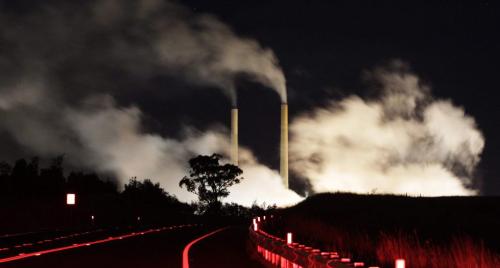President Trump has aimed to undo much of the Obama administration’s policy on energy and climate. This includes announcing a withdrawal from the Paris Climate Agreement, repealing the Clean Power Plan, rolling back vehicle fuel economy standards, attempting to rescind rules on methane emissions from oil and gas production on federal lands, ending the moratorium on coal leasing on federal lands, and opening additional offshore areas to oil and gas leasing.
Each of these undoings shares a common quality: The Obama administration initiated them through regulation or executive order. One could argue that any of the leading candidates in the 2016 Republican primary would have taken similar actions in the climate and energy space. What is needed now, we argue, is momentum toward bipartisan climate legislation in Congress that could outlast the back-and-forth on regulations.
What’s done by an administration can be undone
After the demise of the Waxman Markey legislation in 2009—which would have capped U.S. greenhouse gas emissions—most of the environmental community put all of its eggs in the basket of Obama administration regulation, particularly under the Clean Air Act. Millions of charitable dollars were spent championing the Clean Power Plan and funding climate advocacy for regulatory action.
However, those of us who understand the regulatory process knew the risks of this strategy. Creating a rule, particularly when it seeks to add economically significant new constraints, is incredibly time consuming and involves years of analysis, public comment, interagency coordination, and state implementation. The process is especially subject to litigation when the statutory authority is untested, as it was with Section 111(d) of the Clean Air Act, the basis for the Clean Power Plan.
In contrast, unravelling a rule to remove or reduce regulatory obligations is fairly easy. The administration is likely to be sued when rolling back regulation, but the default is for the new deregulatory language to take effect while the legal case to retain regulation works its way through a years-long process.
Even if litigation to maintain regulation prevails, the administration has great discretion about its stringency. In the case of climate regulation, the Trump administration has revised the social cost of carbon downward, in part by raising the discount rate used to monetize future damages and by reducing the scope of analysis to climate impacts within the borders of the United States. With those changes, stringent emissions standards are unlikely to pass a cost-benefit test.
What does this mean for the next Democratic president’s agenda?
At some point, the United States will elect another Democratic president. This new administration will be tempted to bring back Clean Air Act regulation and other administrative measures to control greenhouse gas emissions, perhaps with even greater stringency than the Obama administration contemplated. For example, the EPA could issue a new Clean Power Plan in short order, given all the work that the agency has already done, but the effort would be as vulnerable to the priorities of the next administration as its predecessor. Even with a tighter timetable, given all the steps involved in promulgating and implementing such a significant rule, including state-level implementation and likely Supreme Court litigation, at least two consecutive Democratic terms would be necessary to make it effective. Therefore, the next Democratic administration must temper its temptation to re-regulate with an understanding that the effort may be futile.
This seesaw of regulatory policy is grossly inefficient, particularly when trying to steer the deployment of long-lived capital toward a lower-carbon future. Markets need durable guidance for investment in cleaner power generation, industrial facilities, and vehicle fleets. Investors need long run signals to develop new low-cost, lower-emitting technologies, which will be essential to drive abatement in the developing world, where emissions are projected to grow the most. Moreover, other countries now see through the Obama administration’s promises and will hold the United States accountable for the lack of credibility in its commitments. Regulation under existing authority is simply not a strong basis for U.S. engagement in international climate diplomacy.
Rather, the next Democratic administration should pursue bipartisan legislation to reduce greenhouse gas emissions. Why bipartisan? Because control of both houses of Congress and the White House may be on the razor’s edge for a long time. Unless the bill includes support from Republicans, it will be repealed in the next Republican administration and Congress, and we end up with a legislative seesaw that is just as bad as the regulatory seesaw we are on now.
Some will argue that courting Republicans will lead to fruitless concessions and ultimately worse policy supported only by Democrats. As we saw with the House version of the American Recovery and Reinvestment Act of 2009, for instance, this is indeed possible. However, we argue that climate legislation is categorically different than a one-and-done stimulus bill. Commitment to reducing emissions must last generations if it is to be successful. And we have seen the dangers of partisanship in the Australian climate policy experience, in which a carbon tax policy adopted in 2011 was promptly dumped in 2014, shortly after government control changed hands. Such as reversal would set American climate policy back for years, as it has in Australia. While some Republicans may remain reticent, increasing numbers in the party see climate inaction as bad for planet and bad for the Republican brand.
What about state and local action? Can’t that be the solution?
Environmental federalism is generally a good idea, but there are at least four problems with this strategy as it pertains to significant greenhouse gas emissions reductions in the United States.
First, concern over competitiveness inherently limits ambition in the states. This concern applies to federal policy as well, but capital is even more mobile across states than across national borders. Additionally, states have limited tools to protect energy-intensive industries. A low carbon price in the power sector is one thing; a higher economy-wide carbon price that covers industrial facilities and transportation fuels is quite another. Few states will want to do that unilaterally.
Second, even with a Democrat in the White House, he or she cannot rely solely on state action to meet a Nationally Determined Contribution (NDC) under the Paris Agreement. State action has been crucial to continuing emissions reductions and engagement in the climate process, but there is no substitute for federal U.S. leadership on climate.
Third, to reduce U.S. emissions significantly, we need action in the climate-skeptical states, where an increasing share of emissions will occur. Without action in the industrial Midwest and the fossil-fuel producing states, we are not really doing the job. Achieving that goal will require federal tools to compensate potential losers in climate policies, such as coal-reliant communities.
Fourth, the most cost-effective and significant avenue for emissions reductions is through fuel switching in the electricity grid, but state and local governments do not control the grid. State and local governments may be able to promote distributed solar and community renewable projects, but to achieve large reductions at lowest cost you need coordination at the grid level. Such coordination is unlikely without federal policy. The same is true for transportation infrastructure.
So what do we do now?
In preparation for an eventual administration and Congress that want to take action on climate, we need to engage now in bipartisan dialogue about legislative action. A legislative approach could provide an efficient price signal and generate revenue to promote growth, reduce the unsustainable deficit, and compensate those who will bear disproportionate burdens. Clear and transparent authority could allow the United States to reengage diplomatically to strong effect.
Those who care about climate must begin planning for new legislation now. Private sector actors and non-governmental organizations will be important in shaping the new climate policy that emerges. The Cross-Brookings Initiative on Energy and Climate focuses on overcoming obstacles to a lower-carbon future. The Brookings Climate and Energy Economics Project is preparing with good economic analysis on carbon pricing. For example, Brookings scholars helped convene the Stanford Energy Modeling Forum 32 exercise with eleven of the best macroeconomic models to model scenarios of a U.S. carbon tax. These are available in a special issue of Climate Change Economics, a peer-reviewed journal. We are also doing work on managing the distributional outcomes of a carbon tax, the implications for states that rely on fossil fuel extraction for revenue, and many other carbon price design choices.
The Brookings Institution is committed to quality, independence, and impact.
We are supported by a diverse array of funders. In line with our values and policies, each Brookings publication represents the sole views of its author(s).











Commentary
Why the climate challenge needs congressional action
April 21, 2018